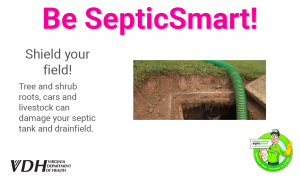
Owning a home served by an onsite sewage (septic) system comes with certain owner responsibilities. Most of these are common sense and in keeping with the maintenance of other household systems such as electrical, heating and cooling components, appliances, roofs, and so forth. Other responsibilities will be associated with operating permits and applicable laws. Let’s walk through it.
Care and Maintenance of Your Onsite System|
The average lifespan of a septic system is 30 to 40 years, but it can last longer if properly maintained. VDH joins with the EPA to urge you to be “SepticSmart”
THINK AT THE SINK: Consider what you put into your toilet and sink and the impact it may have on your system. Many common household items can either clog your system or kill the microbes that treat the wastewater. “Cloggers” include diapers, baby wipes, cat litter, cigarettes, coffee grounds, grease, and feminine hygiene products. “Killers” include household chemicals, gasoline, oil, pesticides, antifreeze, paint, and high amounts of anti-bacterial soaps and detergents.
DON’T STRAIN YOUR DRAIN: The less water you use, the less your septic system has to work. Stagger the use of appliances, use high efficiency plumbing fixtures, and repair any leaks in your home. However, some alternative onsite sewage systems require a minimum amount of flow to operate properly. For more information, go to https://www.epa.gov/watersense/. If you have an alternative onsite sewage system, discuss impacts that low flow or intermittent use might have on your system with your operator.
SHIELD YOUR FIELD: Learn where your septic system is located, and keep your car and anything heavier than your lawnmower off your septic tank and drainfield. Eliminate or limit the use of a garbage disposal. This will significantly reduce the amount of fats, grease, and solids that enter your septic system and could clog your drainfield. Plant trees away from the drainfield since tree roots can clog the field and cause the system to fail. Keep excess water from irrigation, significant rainfall, or drains off the drainfield. |
Inspect and Pump Frequently
Having a septic tank pumped and alternative onsite sewage system maintained at appropriate intervals is as critical as changing the oil in a car. VDH recommends that the average household septic system be inspected at least every three years by a septic service professional. However, alternative onsite sewage systems are required to be inspected at least annually by a licensed operator. Four major factors influence the frequency of septic pumping:
- Household size
- Total wastewater generated
- Volume of solids in wastewater
- Septic tank size
When you call a septic service provider, he or she will inspect for leaks and examine the scum and sludge layers in your septic tank.
SAFETY TIPAn annual septic tank inspection is an excellent time to consider retrofitting at-grade or above grade access ports with a tamper proof and child resistent lid fitted with an interior removable grate or similar secondary feature. |
Household septic tanks should be pumped every three to five years. Why?
- To prevent too much sludge from accumulating in the tank, which prevents settling before sewage flows to the drainfield.
- To maximize the life of the septic tank.
- To prevent the discovery of a septic system failure by the experience of untreated sewage backing up into the house.
Pump outs are legally required in some localities. For example, pump outs are required no less frequently than every five years for systems located in Chesapeake Bay Preservation Areas (although some localities may accept an inspection report performed by a licensed or certified expert in lieu of a pump out). A “Chesapeake Bay Preservation Area” means any land designated by a local government as a Resource Protection Area (RPA) or a Resource Management Area (RMA). Contact your local government for maps of RPAs and RMAs in your community. Other localities or even homeowner associations may have requirements mandating the frequency of pump outs for septic tanks in certain sensitive areas such as near recreational waters or caves. As a homeowner, you are responsible for being aware of all such requirements.
| FIND A SERVICE PROVIDER |
VDH has a septic professional locator that makes it easy to find service professionals in your area; https://www.vdh.virginia.gov/environmental-health/onsite-sewage-water-services-updated/septic-system-and-private-well-service-providers/ . The service provider should note maintenace completed and the tank condition in your system’s service report. VDH recommends that you keep maintenance records on work performed on your septic system.
Alternative Systems
Frequently Asked Questions about your AOSS
Alternative onsite sewage systems (AOSS) have associated performance requirements, including requirements for groundwater protection; laboratory sampling and monitoring; and field measurements, sampling and observations. Owners of AOSS have the responsibility to:
- Have the AOSS operated and maintained by a licensed operator. This will generally involve a service contract.
- Ensure that the operator visits the system at the frequency identified in the operating permit; at least annually.
- Ensure the operator collects required samples.
- Keep a copy of the log provided by the operator where the AOSS is located (may be electronic or hard copy), make the log available to the VDH upon request, and make reasonable effort to transfer the log to any future owner.
- Follow the Operation and Maintenance (O&M) Manual and keep a copy of the O&M Manual on the property where the AOSS is located (may be electronic or hard copy), make the O&M Manual available to the VDH upon request, and make reasonable effort to transfer the O&M Manual to any future owner.
Alternative systems with electrical float switches, pumps, or mechanical components should be inspected more often than conventional systems. If the AOSS is equipped with an alarm and the alarm goes off, immediately contact your service provider.




